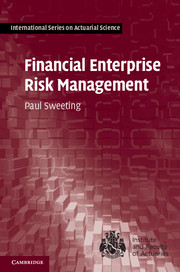Book contents
- Frontmatter
- Contents
- Preface
- 1 An introduction to enterprise risk management
- 2 Types of financial institution
- 3 Stakeholders
- 4 The internal environment
- 5 The external environment
- 6 Process overview
- 7 Definitions of risk
- 8 Risk identification
- 9 Some useful statistics
- 10 Statistical distributions
- 11 Modelling techniques
- 12 Extreme value theory
- 13 Modelling time series
- 14 Quantifying particular risks
- 15 Risk assessment
- 16 Responses to risk
- 17 Continuous considerations
- 18 Economic capital
- 19 Risk frameworks
- 20 Case studies
- References
- Index
10 - Statistical distributions
Published online by Cambridge University Press: 07 October 2011
- Frontmatter
- Contents
- Preface
- 1 An introduction to enterprise risk management
- 2 Types of financial institution
- 3 Stakeholders
- 4 The internal environment
- 5 The external environment
- 6 Process overview
- 7 Definitions of risk
- 8 Risk identification
- 9 Some useful statistics
- 10 Statistical distributions
- 11 Modelling techniques
- 12 Extreme value theory
- 13 Modelling time series
- 14 Quantifying particular risks
- 15 Risk assessment
- 16 Responses to risk
- 17 Continuous considerations
- 18 Economic capital
- 19 Risk frameworks
- 20 Case studies
- References
- Index
Summary
Univariate discrete distributions
The univariate statistical distribution of each variable on its own – also known as its marginal distribution – is an important factor in the risk it poses. Many of the features above can be modelled directly by the appropriate choice of marginal distribution, or they can be added to a more ‘basic’ marginal distribution.
Univariate discrete distributions are generally only used when the number of observations is small, as they quickly become difficult to deal with as the numbers involved increase. However, even if continuous approximations are used, it is important to recognise the nature of whatever is being approximated.
The binomial and negative binomial distributions
The binomial distribution is fundamental to many risks faced. In particular, it reflects the risk of a binary event – one which may or may not occur. Such an event could be the payment of a claim, the default of a creditor or the survival of a policyholder.
The binomial distribution is parameterised by the number of trials (or observations), n, the number of successes (or claims, defaults or other events), x, and the probability that an event will occur, p. The probability must be constant for each trial.
- Type
- Chapter
- Information
- Financial Enterprise Risk Management , pp. 134 - 220Publisher: Cambridge University PressPrint publication year: 2011



